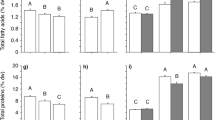Abstract
When Thalassiosira gravida Cleve was grown at low photon-flux densities, its requirements of soil extract for growth could be partially replaced by a mixture of 10 mgl-1 humic acid, 10-7 M gibberellic acid and 5×10-7 M kinetin. The effect of these growth factors was to decrease the lag-phase and increase the number of cells without any qualitative or quantitative change in the pigments associated with photosynthesis. Phaeodactylum tricornutum Bohlin also produced more cells when grown in the presence of these growth factors, although this diatom can be subcultured without soil extract. An improved culture vessel allowed investigations of the two diatoms at low light intensities and illuminated with equal photon-flux densities of white light or blue light (maximum transmission 470 to 520 nm). Growth was always greater on the blue light, but the alteration of chlorophyll levels reported in the literature was not observed. Chlorophyll levels increased during the growth phase, whereas photosynthetic ability reached its maximum on the third or fourth day. The effects of growth factors and blue light on growth were additive and the cells produced had a photosynthetic activity greater than any previously reported. The superiority of equal quanta of blue light over white light in producing more cells can be explained as due to proportionally more quanta in blue light being absorbed by the photosynthetic pigments and thus providing more energy for growth and synthesis. A photosynthetic 14CO2-fixation action spectrum for P. tricornutum showed a maximum in the violet around 451 nm, and a second peak in the red around 678 nm.
Similar content being viewed by others
Literature cited
Bates, S. S.: Determination of the physiological state of marine phytoplankton by use of radiosulphate incorporation. J. exp. mar. Biol. Ecol. 51, 219–239 (1981)
Beardall, J. and I. Morris: The concept of light intensity adaptation in marine phytoplankton: some experiments with Phaeodactylum tricornutum. Mar. Biol. 37, 377–387 (1976)
Carreto, J. I. and J. A. Catoggio: An indirect method for the rapid estimation of carotenoid contents in Phaeodactylum tricornutum: possible application to other marine algae. Mar. Biol. 40, 109–116 (1977)
Davies, D. and E. S. Holdsworth: A method for the estimation of proteins in colored or turbid solutions. Analyt. Biochem. 100, 92–94 (1979)
Davies, D. and E. S. Holdsworth: The use of high pressure liquid chromatography for the identification and preparation of pigments concerned in photosynthesis. J. Liq. Chromat. 3, 123–132 (1980)
Deane, E. M. and R. W. O'Brien: Sulphate uptake and metabolism in the chrysomonad Monochrysis lutheri. Archs Microbiol. 105, 295–301 (1975)
Ebata, T. and Y. Fujita: Changes in the diatom Phaeodactylum tricornutum in a culture of limited volume. Pl Cell Physiol., Tokyo 12, 533–541 (1971)
Griffiths, D. J.: Factors affecting the photosynthetic capacity of laboratory cultures of the diatom Phaeodactylum tricornutum. Mar. Biol. 21, 91–97 (1973)
Gugliemelli, I. A., H. J. Dutton, P. A. Jursinic and H. W. Siegelman. Energy transfer in a light-harvesting carotenoid-chlorophyll c-chlorophyll a-protein of Phaeodactylum tricornutum. Photochem. Photobiol. 33, 903–907 (1981)
Guillard, R. R. L. and J. H. Ryther: Studies of marine planktonic diatoms. I. Cyclotella nana Hustedt, and Detonula confervacea (Cleve) Gran. Can. J. Microbiol. 8, 229–239 (1962)
Haxo, F. T.: The wavelength dependence of photosynthesis and the role of accessory pigments. In: Comparative biochemistry of photoreactive systems. pp 339–360. Ed. by M. B. Allen. London and New York: Academic Press 1960
Holdsworth, E. S. and J. Colbeck: The pattern of carbon fixation in the marine unicellular alga Phaeodactylum tricornutum. Mar. Biol. 38, 189–199 (1976)
Holdsworth, E. S. and H. A. Juzu: A manganese-copper-pigment-protein complex isolated from the photosystem II. of Phaeodactylum tricornutum. Archs Biochem. Biophys. 183, 361–373 (1977)
Humphrey, G. F.: The effect of the spectral composition of light on the growth, pigments, and photosynthetic rate of unicellular marine algae. J. exp. mar. Biol. Ecol. 66, 49–67 (1983)
Jeffrey, S. W. and G. F. Humphrey: New spectrophotometric equations for determining chlorophylls, a, b, c, and c 2in higher plants, algae and natural phytoplankton. Biochem. Physiol. Pfl. 167, 191–194 (1975)
Jeffrey, S. W. and M. Vesk: Effect of blue-green light on photosynthetic pigments and chloroplast structure in the marine diatom Stephanopyxis turris. J. Physiol. 13, 271–279 (1977)
Jerlov, N. G.: Seawater acts as a monochromator of blue light. In: Marine optics, p. 52. Ed. by N. G. Jerlov. Amsterdam: Elsevier 1976. (Elsevier Oceanogr. Ser. No. 14)
Jitts, H. R.: The simulate in situ measurement of oceanic primary production. Aust. J. mar. Freshwat. Res. 14, 139–147 (1963)
Mann, J. E. and J. Myers: On pigments. growth and photosynthesis of Phaeodactylum tricornutum. J. Phycol. 4, 349–355 (1968)
McLachlan, J.: Preparation of soil extract. In: Handbook of phycological methods, p. 41. Ed. by J. R. Stein. Cambridge: University Press 1973
Pedersen, M.: Ectocarpus fasciculatus: marine brown alga requiring kinetin. Nature, Lond. 218, p. 776 (1968)
Provasoli, L., J. J. A. McLaughlin and M. R. Droop: The development of artificial media for marine algae. Arch. Mikrobiol. 25, 392–428 (1957)
Steemann Nielsen, E. and E. G. Jørgensen: The adaptation of plankton algae. I. General part. Physiologia Pl. 21, 401–413 (1968)
Terry, K. L., J. Hirata and E. A. Laws: Light-limited growth of two strains of the marine diatom Phaeodactylum tricornutum Bohlin. J. exp. mar. Biol. Ecol. 68, 209–227 (1983)
Vesk, M. and S. W. Jeffrey: Effect of blue-green light on photosynthetic pigments and chloroplast structure in unicellular marine algae from six classes. J. Physcol. 13, 280–288 (1977)
Author information
Authors and Affiliations
Additional information
Communicated by G. F. Humphrey, Sydney
Rights and permissions
About this article
Cite this article
Holdsworth, E.S. Effect of growth factors and light quality on the growth, pigmentation and photosynthesis of two diatoms, Thalassiosira gravida and Phaeodactylum tricornutum . Mar. Biol. 86, 253–262 (1985). https://doi.org/10.1007/BF00397512
Accepted:
Issue Date:
DOI: https://doi.org/10.1007/BF00397512




